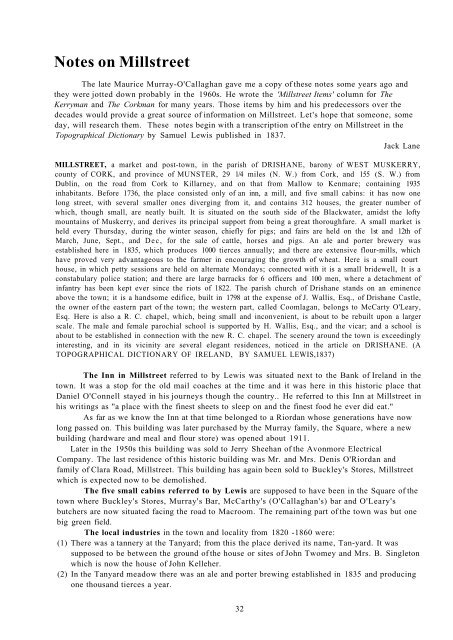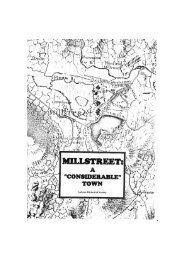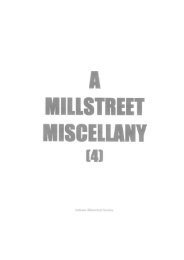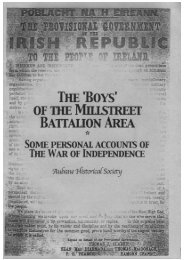A Millstreet Miscellany (3) - Aubane Historical Society
A Millstreet Miscellany (3) - Aubane Historical Society
A Millstreet Miscellany (3) - Aubane Historical Society
Create successful ePaper yourself
Turn your PDF publications into a flip-book with our unique Google optimized e-Paper software.
Notes on <strong>Millstreet</strong><br />
The late Maurice Murray-O'Callaghan gave me a copy of these notes some years ago and<br />
they were jotted down probably in the 1960s. He wrote the '<strong>Millstreet</strong> Items' column for The<br />
Kerryman and The Corkman for many years. Those items by him and his predecessors over the<br />
decades would provide a great source of information on <strong>Millstreet</strong>. Let's hope that someone, some<br />
day, will research them. These notes begin with a transcription of the entry on <strong>Millstreet</strong> in the<br />
Topographical Dictionary by Samuel Lewis published in 1837.<br />
Jack Lane<br />
MILLSTREET, a market and post-town, in the parish of DRISHANE, barony of WEST MUSKERRY,<br />
county of CORK, and province of MUNSTER, 29 1/4 miles (N. W.) from Cork, and 155 (S. W.) from<br />
Dublin, on the road from Cork to Killarney, and on that from Mallow to Kenmare; containing 1935<br />
inhabitants. Before 1736, the place consisted only of an inn, a mill, and five small cabins: it has now one<br />
long street, with several smaller ones diverging from it, and contains 312 houses, the greater number of<br />
which, though small, are neatly built. It is situated on the south side of the Blackwater, amidst the lofty<br />
mountains of Muskerry, and derives its principal support from being a great thoroughfare. A small market is<br />
held every Thursday, during the winter season, chiefly for pigs; and fairs are held on the 1st and 12th of<br />
March, June, Sept., and Dec, for the sale of cattle, horses and pigs. An ale and porter brewery was<br />
established here in 1835, which produces 1000 tierces annually; and there are extensive flour-mills, which<br />
have proved very advantageous to the farmer in encouraging the growth of wheat. Here is a small court<br />
house, in which petty sessions are held on alternate Mondays; connected with it is a small bridewell, It is a<br />
constabulary police station; and there are large barracks for 6 officers and 100 men, where a detachment of<br />
infantry has been kept ever since the riots of 1822. The parish church of Drishane stands on an eminence<br />
above the town; it is a handsome edifice, built in 1798 at the expense of J. Wallis, Esq., of Drishane Castle,<br />
the owner of the eastern part of the town; the western part, called Coomlagan, belongs to McCarty O'Leary,<br />
Esq. Here is also a R. C. chapel, which, being small and inconvenient, is about to be rebuilt upon a larger<br />
scale. The male and female parochial school is supported by H. Wallis, Esq., and the vicar; and a school is<br />
about to be established in connection with the new R. C. chapel. The scenery around the town is exceedingly<br />
interesting, and in its vicinity are several elegant residences, noticed in the article on DRISHANE. (A<br />
TOPOGRAPHICAL DICTIONARY OF IRELAND, BY SAMUEL LEWIS,1837)<br />
The Inn in <strong>Millstreet</strong> referred to by Lewis was situated next to the Bank of Ireland in the<br />
town. It was a stop for the old mail coaches at the time and it was here in this historic place that<br />
Daniel O'Connell stayed in his journeys though the country.. He referred to this Inn at <strong>Millstreet</strong> in<br />
his writings as "a place with the finest sheets to sleep on and the finest food he ever did eat."<br />
As far as we know the Inn at that time belonged to a Riordan whose generations have now<br />
long passed on. This building was later purchased by the Murray family, the Square, where a new<br />
building (hardware and meal and flour store) was opened about 1911.<br />
Later in the 1950s this building was sold to Jerry Sheehan of the Avonmore Electrical<br />
Company. The last residence of this historic building was Mr. and Mrs. Denis O'Riordan and<br />
family of Clara Road, <strong>Millstreet</strong>. This building has again been sold to Buckley's Stores, <strong>Millstreet</strong><br />
which is expected now to be demolished.<br />
The five small cabins referred to by Lewis are supposed to have been in the Square of the<br />
town where Buckley's Stores, Murray's Bar, McCarthy's (O'Callaghan's) bar and O'Leary's<br />
butchers are now situated facing the road to Macroom. The remaining part of the town was but one<br />
big green field.<br />
The local industries in the town and locality from 1820 -1860 were:<br />
(1) There was a tannery at the Tanyard; from this the place derived its name, Tan-yard. It was<br />
supposed to be between the ground of the house or sites of John Twomey and Mrs. B. Singleton<br />
which is now the house of John Kelleher.<br />
(2) In the Tanyard meadow there was an ale and porter brewing established in 1835 and producing<br />
one thousand tierces a year.<br />
32





